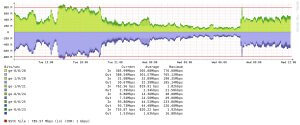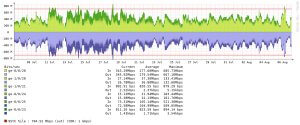Picking the right bandwidth billing model for your dedicated server or cloud setup isn’t just a minor detail – it’s key to keeping things running smoothly without blowing your budget. Whether you’re considering metered, unmetered, or unlimited options, understanding what each means for your wallet and your workflow can make all the difference. Ready to dive in? This guide’s here to help you cut through the jargon and find the bandwidth plan that’s just right for your needs.
Table of Contents
Metered Data Traffic Billing (also known as Volume Traffic) is a method of charging that is based on the volume of data transferred in bytes. Understanding its mechanics and implications is critical for businesses that aim to manage costs while effectively controlling their data flow.
In a metered billing system, you are billed for each gigabyte of data transferred to and from your server that exceeds the monthly allowance included in your plan. At the end of each month, you receive a clear bill that reflects the total data transferred, highlighting both inbound (data received) and outbound (data sent) data. This approach offers transparency in data usage, allowing businesses to monitor their total in and out effectively.
Additional charges are calculated based on the pre-agreed per GB rate for any data transferred beyond the monthly allowance. This rate depends on the chosen network performance type and data traffic commitment, enabling businesses to anticipate potential costs associated with exceeding their data allowances.
To avoid unexpected surcharges, businesses can implement the following strategies:
Monitoring Tools: Utilize data monitoring tools to track real-time usage and receive alerts when approaching the data limit.
Data Compression: Employ data compression techniques to reduce the volume of data transferred, thereby lowering overall costs.
Traffic Analysis: Regularly analyze traffic patterns to better predict usage and adjust plans accordingly, ensuring the best fit for business needs.
Prioritization of Data: Identify critical data and prioritize essential traffic to manage and minimize unnecessary data transfer.
Metered billing is particularly suited for small to medium-sized businesses that experience consistent traffic patterns, as well as those on a tight budget who seek to manage their costs effectively. It is ideal for customers looking for a cost-effective solution for a single or a few compute resources.
Unmetered Bandwidth Billing provides a flat fee structure, allowing businesses to focus on operations without worrying about fluctuating bandwidth costs.
This option involves a fixed monthly fee for a specific maximum port speed, ensuring predictable billing. You can use as much bandwidth as needed without worrying about overage charges, as long as you remain within the speed limits set in the agreement.
Unmetered billing offers financial certainty and eliminates the risk of unexpected costs due to traffic spikes. However, the server cannot exceed the predetermined speed limit set in the agreement.
This model is favored by businesses with high and consistent data usage, such as streaming services or large e-commerce sites that experience regular traffic.
Metered Burstable Billing offers a flexible approach to bandwidth usage, accommodating short-term surges while maintaining cost control.
This method allows for temporary increases in bandwidth usage, billing you based on the 95th percentile calculation. In this calculation, the highest 5% of either inbound or outbound bandwidth usage (whichever is higher) is excluded, and only the remaining 95% is billed. This approach is particularly beneficial for businesses with fluctuating traffic patterns, as it provides the flexibility to handle short-term surges without a long-term commitment to higher bandwidth levels.

This graph shows traffic over a month-long period.

This graph focuses on traffic over a single 24-hour period.

Aggregates traffic data from multiple servers/locations over a 24-hour period.
This graph aggregates traffic data from multiple servers and locations over a 24-hour period.

Aggregates traffic data from multiple servers/locations over a month.
Metered burstable billing is ideal for handling unpredictable traffic spikes. For example, if your server experiences a sudden surge in visitors due to a marketing campaign or seasonal demand, this billing method allows you to accommodate the increased load without incurring permanent higher costs. The system calculates your usage by sampling traffic every five minutes and discarding the highest 5%, which can include up to 36 hours of peak traffic in a month without additional charges.
The billing is based on the pre-agreed Mbps rate, making it easier to manage costs. You only pay for what you use beyond the 95th percentile, avoiding the need to over-provision bandwidth that may go unused during off-peak times. This ensures a cost-effective solution where you can scale bandwidth usage according to actual needs rather than hypothetical maximums.
Through the customer portal, you can track your 95th percentile usage in real-time. This transparency helps in proactive bandwidth management, allowing you to anticipate potential overages and adjust your usage patterns accordingly. The portal provides detailed insights and reports, enabling you to make informed decisions about your bandwidth needs.
Industry Standard
The 95th percentile billing method is an industry-standard approach used by many providers. It ensures that you have the bandwidth capacity to meet short-term demands while maintaining predictable costs. This method is particularly advantageous for businesses that experience variable traffic patterns, ensuring that you are not penalized for brief periods of high usage.
This method is ideal for companies with seasonal traffic peaks or those running marketing campaigns that cause occasional spikes in data usage.
Unmetered bandwidth offers a consistent flow of data transfer at a fixed speed without a data ceiling, making it an excellent choice for high-traffic sites needing reliable performance.
Unmetered bandwidth allows for unlimited data transfer at a predetermined speed, ensuring consistent performance without the risk of overage fees. However, the fixed speed cap can limit data delivery during peak periods, and the higher capacity requirements might increase costs.
Unmetered bandwidth is suitable for sites needing consistent performance, such as high-traffic blogs and media streaming services, where data flow must remain uninterrupted.
Unmetered dedicated servers offer a straightforward pricing structure, which can be particularly advantageous for businesses with unpredictable traffic patterns or those expecting rapid growth. These servers provide a flat-rate billing model, ensuring no surprises in terms of bandwidth costs, and allow for extensive data transfer without additional fees.
Unmetered servers allow businesses to pay for the connection speed rather than data transfer volume. This means companies can utilize as much bandwidth as their connection allows without incurring additional costs, offering peace of mind and simplifying financial planning.
Effective bandwidth management relies on real-time monitoring and detailed reporting to ensure optimal performance and cost-efficiency.
The 95th percentile method is a recognized industry standard, providing a balanced approach to bandwidth billing by accommodating peak usage without leading to punitive costs for brief spikes.
Selecting the right bandwidth option is essential for optimizing performance and managing costs effectively. Whether you require predictable monthly fees or flexible usage-based billing, understanding these options will help you make an informed decision that aligns with your specific needs.
If you have questions or need personalized advice on choosing the best bandwidth solution for your business, please contact us to explore your options and get tailored recommendations.
For personalized support on optimizing bandwidth, reach out to our experts here: Netrouting
